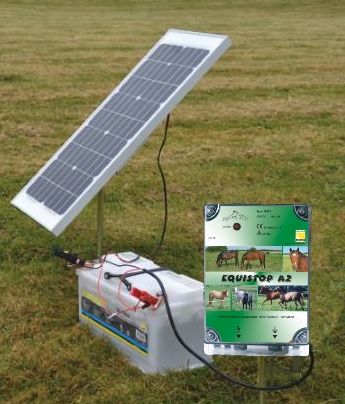You have no items in your shopping cart.
The decision to use Electric Fencing situated in remote areas has been at a disadvantage due to the necessity of a regular power source normally supplied by a 12v recyclable battery. When using the larger 6 joule energisers drawing up to 500 mAmps this may be as frequent as every two weeks. Even then, as the voltage in the battery drops so does that in the fence as the energiser is a complex transformer converting the 9 v to the running 6000+ volts. During recent years the development of advanced solar collection systems has changed the attitude of suppliers to this form of energy. In the past a panel could convert less than 5% of the energy available. However the efficiency of the modern monocrystalline panels run at nearly 20% and are better able to convert ambient light as well as direct sunlight to electricity. As a result a panel is no longer only suitable in the summer months and may now be used in the winter period as well.
Solar powered electric energisers work by first collecting and then converting natural sunlight through special paneling named solar PV panels. This energy is then diverted to power packs (batteries) ready to be released when the energiser draws power. The arguments for installing a solar electrified fence.
- A solar powered electric fence is able to run without access to mains electricity, this allows you to erect fences where it would usually be tough or not worthwhile. Isolated areas such as mountaintops or meadows can be contained without needing to struggle up and down every few days to replace the battery. A solar panel will energise the battery by day and the battery will provide energy to the electric fence all the time.
- Solar electrified fences are transportable Solar powered fence energisers are easy to move if you intend to relocate your fence to a different plot. This is particularly useful should you decide to relocate cattle to graze in different areas. Unlike mains charged fences which need to remain near to a power source, Solar powered electrified fences can be taken down and re-built anywhere they are needed.
- A battery will last longer by not being constantly drained of its charge. A battery who's charge is maintained will last longer than one that is constantly being drained and recharged.
- Another common problem with energisers are power surges between the main source of energy and the fence system. Solar powered chargers just do not fail this way. They can't because they are not hooked up to the main electrical energy source.
- The longer the section of fence you want to energise, the stronger the energiser you will need. These larger energisers will create a greater draw on the battery so a larger solar panel will be required.
 When selecting a place in which to use your solar powered electric fence it is important to put thought to where to place the solar panel for the best exposure to the sun's rays. The rest of your fence can be blocked by cloud but the panel must have access to as much direct sunlight as possible. Once you have decided on the placement of your PV Panels stop and ask yourself whether this panel will have sunlight year round or could a switch in season stop its access to sunlight. For this reason it is also advisable to check your panels once a month to ensure that they are constantly angled at an appropriate angle. In order to insure that an Electric Fence will remain functioning during the long winter months it is suggested that a larger than required panel is used. All modern panels protect the battery from over charging so there is no need to be concerned with batteries being damaged. A reasonable rule of thumb would be a 10 watt panel for energisers under 3 joules, a 20 watt panel for energisers over this.
When selecting a place in which to use your solar powered electric fence it is important to put thought to where to place the solar panel for the best exposure to the sun's rays. The rest of your fence can be blocked by cloud but the panel must have access to as much direct sunlight as possible. Once you have decided on the placement of your PV Panels stop and ask yourself whether this panel will have sunlight year round or could a switch in season stop its access to sunlight. For this reason it is also advisable to check your panels once a month to ensure that they are constantly angled at an appropriate angle. In order to insure that an Electric Fence will remain functioning during the long winter months it is suggested that a larger than required panel is used. All modern panels protect the battery from over charging so there is no need to be concerned with batteries being damaged. A reasonable rule of thumb would be a 10 watt panel for energisers under 3 joules, a 20 watt panel for energisers over this.
There are tricks available to increase the output of a solar panel. A mirror placed so that it reflects suns rays on bto the panel will boost output. Care must be taken as it is possible to burn out the panel.








← Older Post Newer Post →
0 comments